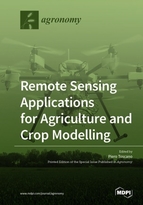Remote Sensing Applications for Agriculture and Crop Modelling
A special issue of Agronomy (ISSN 2073-4395). This special issue belongs to the section "Innovative Cropping Systems".
Deadline for manuscript submissions: closed (31 May 2019) | Viewed by 92404
Special Issue Editor
Interests: remote sensing; precision agriculture; crop modeling; climate services
Special Issues, Collections and Topics in MDPI journals
Special Issue Information
Dear Colleagues,
Crop models and remote sensing techniques have been combined and applied in agriculture and crop estimation on local and regional scales, or worldwide, based on the simultaneous development of crop models and remote sensing. The literature shows that many new remote sensing sensors and valuable methods have been developed for the retrieval of canopy state variables and soil properties from remote sensing data for assimilating the retrieved variables into crop models. At the same time, remote sensing has been used in a staggering number of applications for agriculture. With this Special Issue we will compile state-of-the-art research that specifically addresses and provides new steps in expanding the scope of remote sensing and modelling for agricultural systems: Data assimilation in mechanistic crop growth models, local to global monitoring activities (e.g., crop identification and crop surface estimation, crop forecasting, crop health analysis and assessment of crop damage), and applications of remote sensing at the farm level (e.g., crop condition assessment and stress detection, identification of pests and disease infestation, retrieval of quantity and quality crop characteristics). Model–data assimilation and model–data fusion contributions are welcomed, as are papers describing new management applications of remote sensing in agriculture.
Dr. Piero Toscano
Guest Editor
Manuscript Submission Information
Manuscripts should be submitted online at www.mdpi.com by registering and logging in to this website. Once you are registered, click here to go to the submission form. Manuscripts can be submitted until the deadline. All submissions that pass pre-check are peer-reviewed. Accepted papers will be published continuously in the journal (as soon as accepted) and will be listed together on the special issue website. Research articles, review articles as well as short communications are invited. For planned papers, a title and short abstract (about 100 words) can be sent to the Editorial Office for announcement on this website.
Submitted manuscripts should not have been published previously, nor be under consideration for publication elsewhere (except conference proceedings papers). All manuscripts are thoroughly refereed through a single-blind peer-review process. A guide for authors and other relevant information for submission of manuscripts is available on the Instructions for Authors page. Agronomy is an international peer-reviewed open access monthly journal published by MDPI.
Please visit the Instructions for Authors page before submitting a manuscript. The Article Processing Charge (APC) for publication in this open access journal is 2600 CHF (Swiss Francs). Submitted papers should be well formatted and use good English. Authors may use MDPI's English editing service prior to publication or during author revisions.
Keywords
- remote sensing
- model
- assimilation
- fusion
- yield
- spatio-temporal scale
- crop biophysical variables
- crop status
- crop identification and crop area
- precision agriculture






